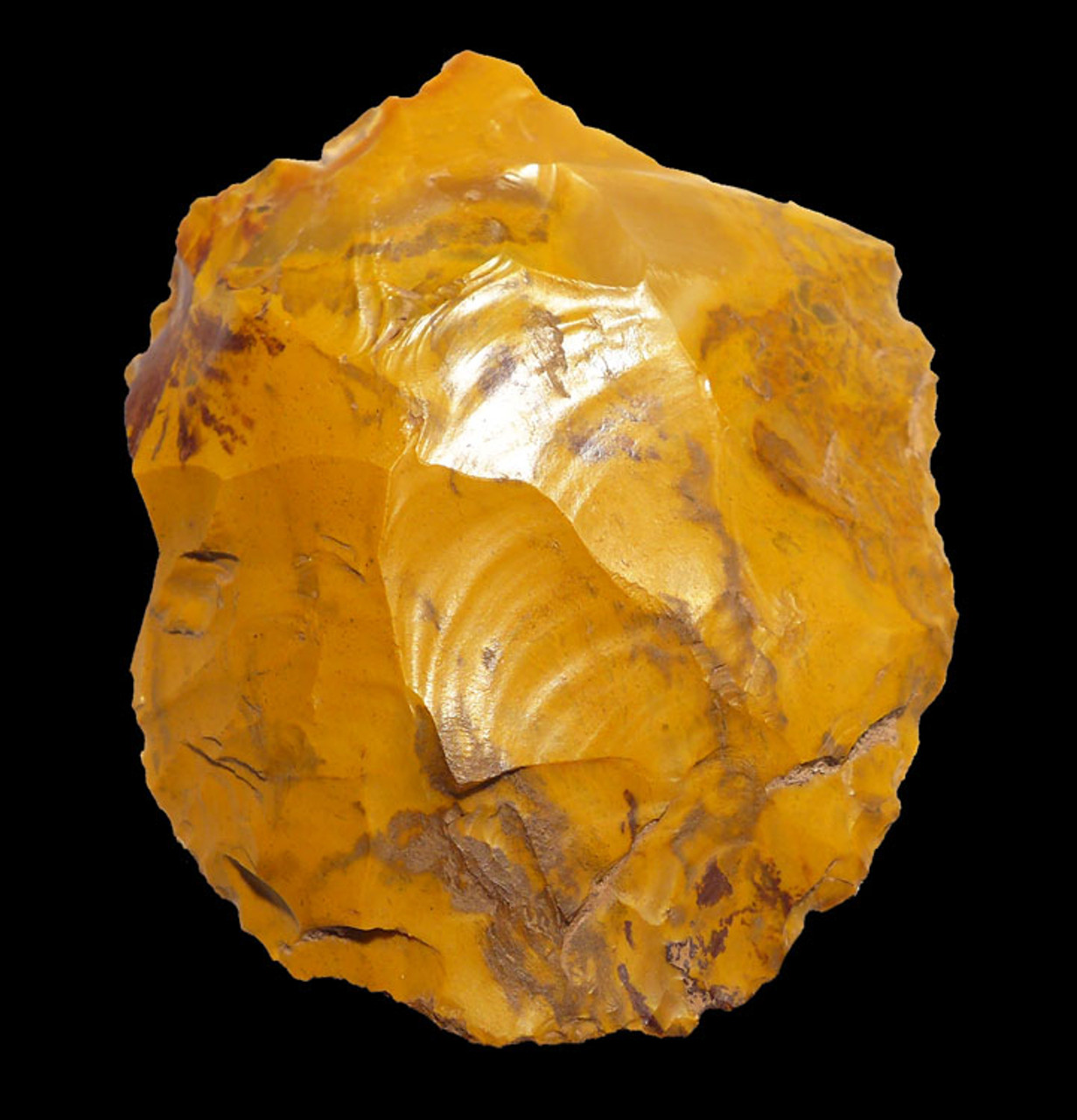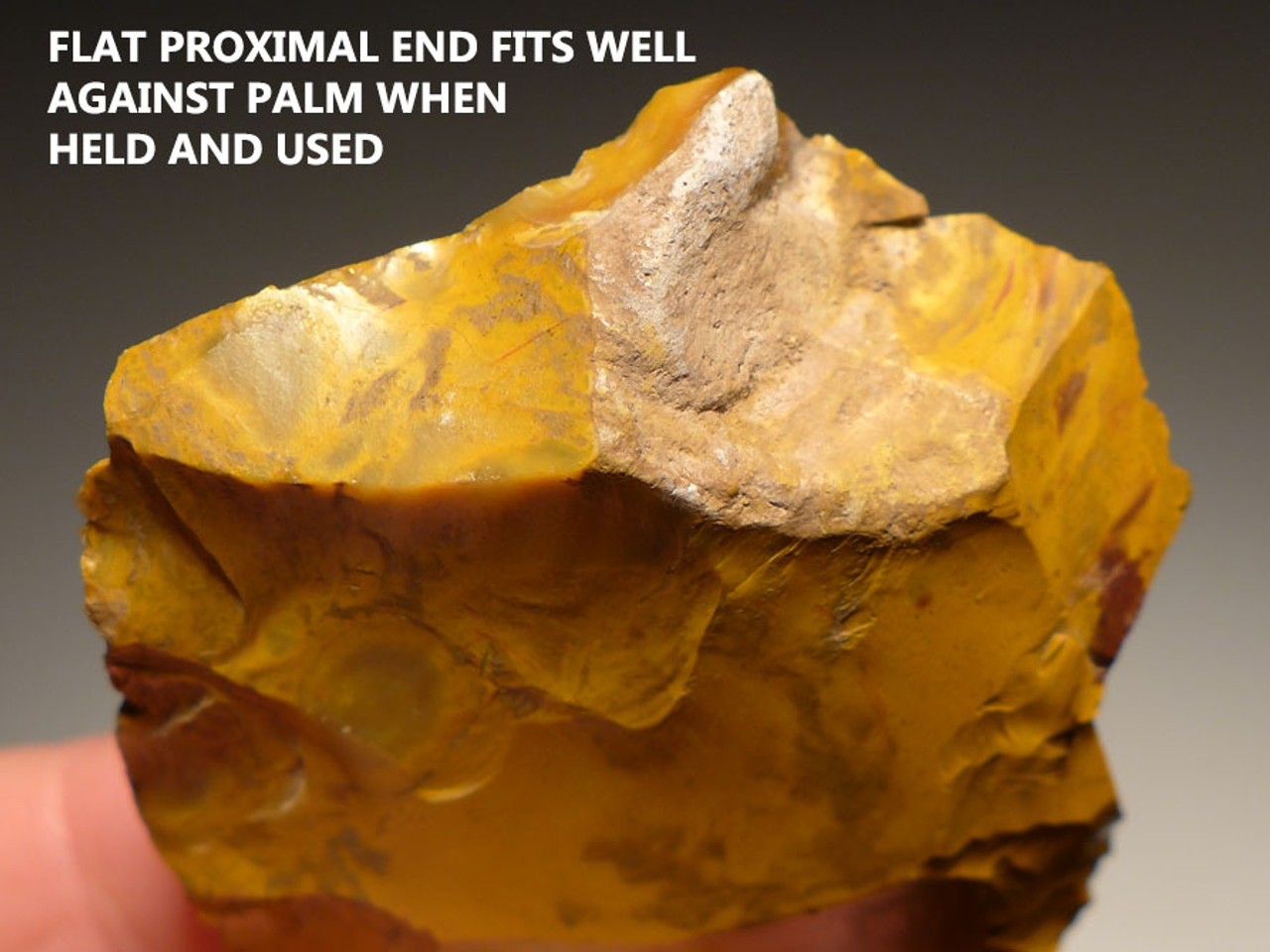Product Description
ID
|
Mousterian Handaxe Biface
|
||
FOUND
|
Open Site - Fontmaure,
|
||
AGE
|
MOUSTERIAN: 80,000 - 40,000 years
|
||
SIZE
|
2.5" long x 2.2" across
|
||
CONDITION
|
INTACT AND COMPLETE.
|
||
NOTE
|
SELDOM ARE FONTMAURE JASPER
|
||
INCLUDES DISPLAY BOX - Actual Item - One Only
Comes with a certificate of |
|||
CLICK HERE TO LEARN MORE ABOUT MOUSTERIAN TOOLS
Judging by its meticulous flaking and workmanship, far exceeding what would have been needed on a utilitarian level, no doubt this Neanderthal BIFACE HANDAXE was a PRESTIGE PIECE. Far more scarce than scrapers, HANDAXES from Fontmaure are extremely rare and only very seldom found on the open market. This rare, beautiful handaxe was fashioned by Neanderthals over 40,000 years ago out of gem-grade colorful jasper known to occur ONLY from Fontmaure, located in West Central France. The EXCLUSIVE prehistoric site this specimen was collected from is only approximately 1 acre in size and is now closed and protected by the government. This rare artifact was legally collected with the landowner's permission decades ago before the area was sealed. Fontmaure is one of Europe's most famous Neanderthal sites and the fact that this small unique prehistoric site is off-limits to any collecting, makes this wonderful stone tool artifact exceedingly rare and desirable!
The form and execution of this extraordinary handaxe was fashioned by a Neanderthal in classic MOUSTERIAN TRADITION. Unlike their much larger predecessors of the Sahara during the Acheulian, Mousterian handaxes are much smaller in comparison. Not only are Mousterian handaxes considered some of the rarest and most prized tools of the Neanderthals, this exquisite representation is a perfectly executed BIFACIAL example. A prominent proximal end knapped base rests up against the palm for comfort. Narrow and delicate pointed tip is still intact and unbroken which is EXTREMELY RARE for specimens like this. The entire surface features a rich, heavy soil sheen patina. Superb shaping and delicate secondary flaking over faces and edges. As a testament to its authenticity and age, these seams provide irrefutable proof evidenced by the presence of minerals deep in these microscopic crevices. This is one of the nicest Neanderthal hand axes we have offered in quite some time. NO RESTORATION, REPAIR OR MODERN DAMAGE.
Unlike inferior surface-collected specimens that occasionally are offered on the market, this artifact was dug from the actual subterranean level that was once a Neanderthal occupation layer. What this means is that it was not weathered and damaged by exposure to the elements or plow. This entire specimen is in perfect, AS MADE condition with a rich natural soil sheen from long-term sediment burial. Original minerals and patina deep in microscopic crevices and hinge fractures provide evidence of its prehistoric authenticity, traits not found in modern or altered copies. NO RESTORATION, REPAIR OR MODERN DAMAGE. Our fortunate purchase of a very old private Belgian collection allows us to offer this SCARCE Neanderthal artifact.
Out of the many archaeological sites in France containing Paleolithic objects, Fontmaure is one of the "Crown Jewels" of the period of the Neanderthals. This site is very small, spanning only approximately one acre. It gets its name from the neighboring farm where it is located. Artifacts from Fontmaure have been dated to at least 40,000 years old and are classified as from the Chatelperronian and Mousterian era, having been fashioned by the Neanderthal people. One of the unique published finds of Fontmaure is the very beautiful and unique jasper which is only found here and is primarily red and yellow. Many of the objects found in Fontmaure are made of this stone with other objects made of sandstone, flint and light gray quartz. This light gray quartz originates from a place that is situated about hundred kilometers from Fontmaure. Another unusual feature is that, to date, it is one of a few known open-air settlements. Even more interesting is the fact that along with the stone tools found, human and animal figures have also been excavated. There are also stones used in some type of ritual, such as triangular stones, round discs and stone balls (bolas) that have been discovered in Fontmaure. These art objects of the Neanderthals make up some of the oldest art known from Europe! Today, we find the unusual, bright colors of the Fontmaure Neanderthal tools to be intriguingly beautiful and no doubt, the Neanderthals of prehistory coveted and prized these pieces, as well!
Fine quality Mousterian Neanderthal tools are rare and often move from one private collection to the next as most sites are now depleted, destroyed, built over and all are protected by law forbidding modern day digging. It is probable by simple logistics, that over time, high grade archeological tools will most definitely appreciate as collector demand continues to outpace the finite supply circulating amongst collectors that buy pieces and never resell. Investment aside, no Paleolithic collection should be without representative tools of one of the most famous primitive humans in history!
 US DOLLAR
US DOLLAR
 EURO
EURO
 AUSTRALIAN DOLLAR
AUSTRALIAN DOLLAR
 CANADIAN DOLLAR
CANADIAN DOLLAR
 POUND STERLING
POUND STERLING


































